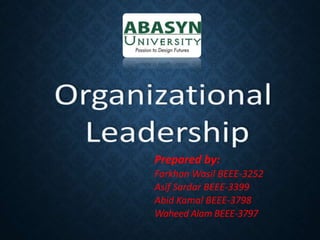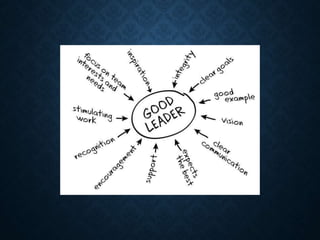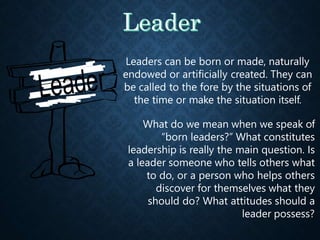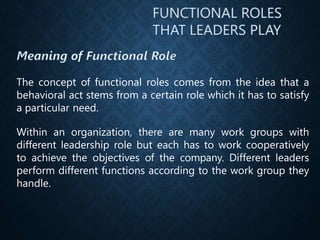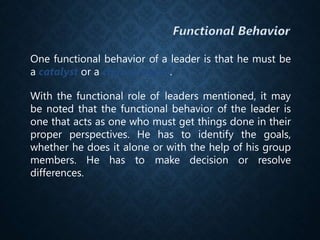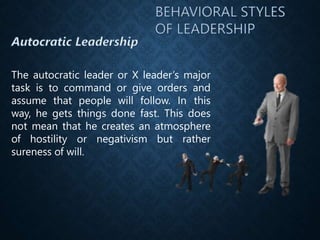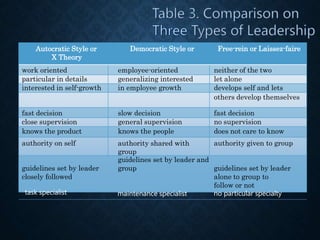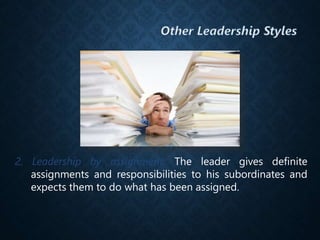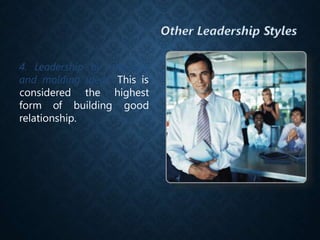organizationalleadership-141024120423-conversion-gate01 (1).pptx
- 1. Prepared by: Farkhan Wasil BEEE-3252 Asif Sardar BEEE-3399 Abid Kamal BEEE-3798 Waheed Alam BEEE-3797
- 3. Leaders can be born or made, naturally endowed or artificially created. They can be called to the fore by the situations of the time or make the situation itself. What do we mean when we speak of “born leaders?” What constitutes leadership is really the main question. Is a leader someone who tells others what to do, or a person who helps others discover for themselves what they should do? What attitudes should a leader possess?
- 4. The concept of functional roles comes from the idea that a behavioral act stems from a certain role which it has to satisfy a particular need. Within an organization, there are many work groups with different leadership role but each has to work cooperatively to achieve the objectives of the company. Different leaders perform different functions according to the work group they handle.
- 5. The functions of the leader may be: direct, such as choosing the group goal, supervising performances, making decisions, or completing plans or it may be more complex such as serving as the group ego The group ego develops from the individual egos of the group members; the group ego develops by: a. integrating the group’s needs and goals with reality outside the group b. satisfying interpersonal needs within the group c. creating an atmosphere free of conflict for group member
- 6. In addition, the leader must: • know himself and his men • keep his employees informed • set the example • make sound and timely decision • develop a sense of responsibility among subordinates through proper supervision and delegation of authority and responsibility • take responsibility of his actions and the action of subordinates
- 7. One functional behavior of a leader is that he must be a catalyst or a change agent. With the functional role of leaders mentioned, it may be noted that the functional behavior of the leader is one that acts as one who must get things done in their proper perspectives. He has to identify the goals, whether he does it alone or with the help of his group members. He has to make decision or resolve differences.
- 8. Another functional behavior of a leader therefore is that he must now be more sensitive to the complexities of the times and thus be more flexible. Leaders who can transcend special interest and bring people together are needed. There is, therefore, a need for leaders to grow or decay. “They must be flexible to venture into the unknown odds of tomorrow for they must set the future in motion by gambling reasonably but fearlessly.” (Appendix VII – Special Requirements for Higher Executives)
- 9. The success or failure of any organization is through their leadership behavior. Leadership styles is generally reflected in the behavior patterns of the leader. Proper choice of leadership style will result good followers and high productivity. A wrong choice will result in lack of cooperation of followers, low morale, and low productivity.
- 10. The autocratic leader or X leader’s major task is to command or give orders and assume that people will follow. In this way, he gets things done fast. This does not mean that he creates an atmosphere of hostility or negativism but rather sureness of will.
- 11. • Instructions are given in detail with care and precision. • Autocratic communication is essentially one-way with nil feedback which may result to misunderstanding and subsequent error. • The leader does not know directly what the employees feel and think. • He makes decision without consulting others.
- 12. Participative leaders or Y leaders invite the active participation of subordinates to share in decision-making process as much as possible. Primary concern: Develop group interrelationship as well as getting the job done.
- 13. Participative communication is a two-way process. This requires patience and a great deal of energy on the part of the leader to stir the group into participating in planning and deciding so work may be accomplished effectively.
- 14. Two types of Participative Leadership 1. Democratic Leader – one who emphasizes on his subordinates their authority to make decisions and abide by such decisions with no exceptions. 2. Consultative Leader – this requires a high degree of involvement from employees but it is clear that they alone have the authority to make the final decisions.
- 15. Advantages of Participative Leadership 1. Group interrelationship is high. 2. Members abide by whatever the group decides. 3. It supports decisions more enthusiastically and tries hard to make them work. 4. There is high productivity. 5. It maximizes individuals potential in creative and productive way and experience personal satisfaction and accomplishment of their work tasks. 6. Workers take on more responsibility than their job description calls for.
- 16. Disadvantages consuming and great deal of 1. Time requires energy. 2. Maybe used by people with authority as a guise for shirking from their own responsibilities.
- 17. Free-rein leaders are also referred to as laissez-faire leaders. Free-rein leaders give their subordinates the goals and guidelines of their jobs with little direction and leave the rest to them.
- 18. The free-rein leader, though possessed with decision- making authority, may not use such authority but leave everything to his group to carry on what they think is best.
- 19. Y Theory Autocratic Style or X Theory Democratic Style or Free-rein or Laissez-faire work oriented employee-oriented neither of the two particular in details generalizing interested let alone interested in self-growth in employee growth develops self and lets others develop themselves fast decision slow decision fast decision close supervision general supervision no supervision knows the product knows the people does not care to know authority on self authority shared with group authority given to group guidelines set by leader and guidelines set by leader group guidelines set by leader closely followed alone to group to follow or not task specialist maintenance specialist no particular specialty
- 20. Laird and Laird believe that types of leadership have a relationship with the family upbringing, therefore, has a psychological basis. They mentioned four methods of leadership as: 1. Coercive leadership. This is considered the lowest grade of leadership. It tells subordinate to “do this or else. . .”
- 21. 2. Leadership by assignment. The leader gives definite assignments and responsibilities to his subordinates and expects them to do what has been assigned.
- 22. 3. Leadership by teaching and explaining. Here the leader takes pain in teaching and explaining to the group what is to be done and what he expects from them.
- 23. 4. Leadership by inspiring and molding ideas. This is considered the highest good form of building relationship.
- 24. “A good objective of leadership is to help those who are doing poorly to do well and to help those who are doing well to do even better.” - Jim Rohn “If your actions inspire others to dream more, learn more, do more, and become more, you are a leader.” - John Quincy Adams
- 25. “One of the most important leadership lessons is realizing you’re not the most important or the most intelligent person in the room at all times.” - Mario Batali ***
